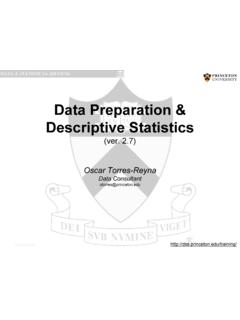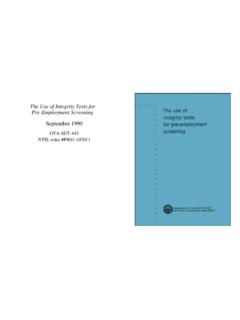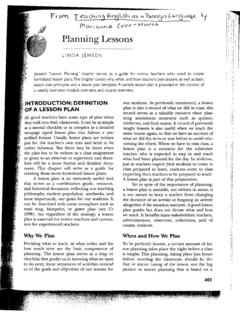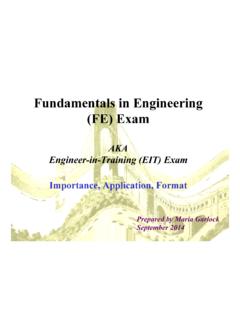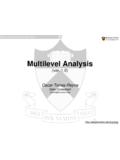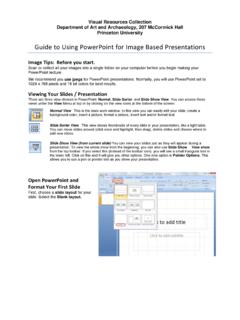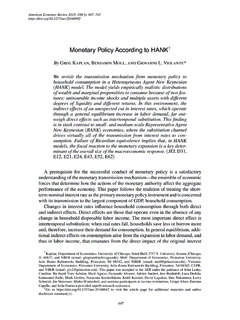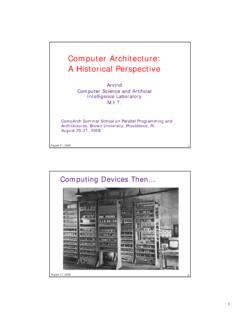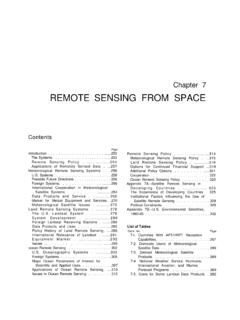Transcription of Lecture 02: One Period Model - Princeton University
1 Fin 501: Asset PricingSlide 2-110:37 Lecture 02 One Period ModelLecture 02: One Period ModelProf. Markus K. BrunnermeierFin 501: Asset PricingSlide 2-210:37 Lecture 02 One Period Structure Arrow-Debreu securities structure Redundant securities Market completeness Completing markets with (no arbitrage, state prices, SDF, EMM ..)Fin 501: Asset PricingSlide 2-310:37 Lecture 02 One Period ModelThe Economy State space (Evolution of states) Two dates: t=0,1 Sstates of the world at time t=1 Preferences U(c0, c1, ..,cS) (slope of indifference curve) Security structure Arrow-Debreu economy General security structure0s=1s=2s= 501: Asset PricingSlide 2-410:37 Lecture 02 One Period ModelSecurity Structure Security jis represented by a payoff vector Security structure is represented by payoff matrix NB.
2 Most other books use the transpose of X as payoff 501: Asset PricingSlide 2-510:37 Lecture 02 One Period ModelOneA-D asset e1= (1,0)Payoff Space <X>This payoff cannot be replicated!Arrow-Debreu Security Structure in R2)Markets are incompletec1c2 Fin 501: Asset PricingSlide 2-610:37 Lecture 02 One Period ModelAdd secondA-D asset e2= (0,1) to e1= (1,0)Arrow-Debreu Security Structure in R2c1c2 Fin 501: Asset PricingSlide 2-710:37 Lecture 02 One Period ModelArrow-Debreu Security Structure in R2 Payoff space <X>Any payoff can be replicated with two A-D securitiesc1c2 Add secondA-D asset e2= (0,1) to e1= (1,0)Fin 501: Asset PricingSlide 2-810.
3 37 Lecture 02 One Period ModelArrow-Debreu Security Structure in R2 Payoff space <X>New asset is redundant it does not enlarge the payoff spacec1c2 Add secondasset (1,2) toFin 501: Asset PricingSlide 2-910:37 Lecture 02 One Period ModelArrow-Debreu Security Structure SArrow-Debreu securities each state scan be insured individually All payoffs are linearly independent Rank of X = S Markets are completeFin 501: Asset PricingSlide 2-1010:37 Lecture 02 One Period ModelGeneral Security StructureOnly bondPayoff space <X>c1c2 Fin 501: Asset PricingSlide 2-1110:37 Lecture 02 One Period ModelGeneral Security StructureOnly bond xbond= (1,1)Payoff space <X>can t be reachedc1c2 Fin 501: Asset PricingSlide 2-1210:37 Lecture 02 One Period ModelAdd security (2,1) to bond (1,1)General Security Structurec1c2 Fin 501: Asset PricingSlide 2-1310:37 Lecture 02 One Period Model Portfolio of buy 3 bonds sell short 1 risky assetGeneral Security Structurec1c2 Add security (2,1) to bond (1,1)Fin 501: Asset PricingSlide 2-1410.
4 37 Lecture 02 One Period ModelPayoff space <X>Market are complete with security structurePayoff space coincides with payoff space ofGeneral Security StructureTwo assets spanthe payoff spacec1c2 Fin 501: Asset PricingSlide 2-1510:37 Lecture 02 One Period Model Portfolio: vector h2RJ (quantity for each asset) Payoff of Portfolio h is jhjxj= h X Asset span <X> is a linear subspace of RS Complete markets <X>= RS Complete markets if and only if rank(X)= S Incomplete marketsrank(X) < S Security jis redundant if xj= h X with hj=0 General Security StructureFin 501: Asset PricingSlide 2-1610:37 Lecture 02 One Period ModelIntroducing derivatives Securities: property rights/contracts Payoffs of derivatives derivefrom payoff of underlying securities Examples: forwards, futures, call/put options Question:Are derivatives necessarily redundant assets?
5 Fin 501: Asset PricingSlide 2-1710:37 Lecture 02 One Period ModelForward contracts Definition: A binding agreement (obligation) to buy/sell an underlying asset in the future, at a price set today Futures contracts are same as forwards in principle except for some institutional and pricing differences A forward contract specifies: The features and quantity of the asset to be delivered The delivery logistics , such as time, date, and place The price the buyer will pay at the time of deliveryTodayExpirationdateFin 501: Asset PricingSlide 2-1810:37 Lecture 02 One Period ModelReading price quotesIndex futuresExpiration monthThe openpriceHigh of the dayLowof the daySettlement price(last transaction of the day)Daily changeLifetime highLifetime lowOpen interestFin 501: Asset PricingSlide 2-2010:37 Lecture 02 One Period ModelPayoff diagram for forwards Long and short forward positions on the S&R 500 index:Fin 501: Asset PricingSlide 2-2110:37 Lecture 02 One Period ModelForward vs.
6 Outright purchase Forward + bond = Spot price at expiration -$1,020 +$1,020= Spot price at expirationForward payoffBond payoffFin 501: Asset PricingSlide 2-2210:37 Lecture 02 One Period ModelAdditional considerations (ignored) Type of settlement Cash settlement: less costly and more practical Physical delivery: often avoided due to significant costs Credit risk of the counter party Major issue for over-the-counter contracts Credit check, collateral, bank letter of credit Less severe for exchange-traded contracts Exchange guarantees transactions, requires collateralFin 501: Asset PricingSlide 2-2310:37 Lecture 02 One Period Model A non-binding agreement (right but not an obligation) to buy an asset in the future, at a price set today Preserves the upside potential ( ), while at the same time eliminating the unpleasant ( ) downside (for the buyer) The seller of a call option is obligated to deliver if askedCall optionsTodayExpirationdateorat buyer s choosingFin 501: Asset PricingSlide 2-2510.
7 37 Lecture 02 One Period ModelDefinition and terminology A call optiongives the owner the right but not the obligation to buythe underlying asset at a predetermined price during a predetermined time Period Strike (or exercise) price: The amount paid by the option buyer for the asset if he/she decides to exercise Exercise: The act of paying the strike price to buy the asset Expiration: The date by which the option must be exercised or become worthless Exercise style: Specifies when the option can be exercised European-style: can be exercised only at expiration date American-style: can be exercised at any time before expiration Bermudan-style: can be exercised during specified periodsFin 501: Asset PricingSlide 2-2610:37 Lecture 02 One Period ModelReading price quotesS&P500 Index optionsStrike priceFin 501: Asset PricingSlide 2-2710:37 Lecture 02 One Period ModelPayoff/profit of a purchased call Payoff = max[0, spot price at expiration strike price] Profit = Payoff future value of option premium Examples &.
8 S&R Index 6-month Call Option Strike price = $1,000, Premium = $ , 6-month risk-free rate = 2% If index value in six months = $1100 Payoff = max[0, $1,100 -$1,000] = $100 Profit = $100 ($ x ) = $ If index value in six months = $900 Payoff = max[0, $900 -$1,000] = $0 Profit = $0 ($ x ) = -$ 501: Asset PricingSlide 2-2810:37 Lecture 02 One Period ModelDiagrams for purchased call Payoff at expiration Profit at expirationFin 501: Asset PricingSlide 2-3010:37 Lecture 02 One Period Model A put optiongives the owner the right but not the obligation to sellthe underlying asset at a predetermined price during a predetermined time Period The seller of a put option is obligated to buy if asked Payoff/profit of a purchased ( , long) put: Payoff = max[0, strike price spot price at expiration] Profit = Payoff future value of option premium Payoff/profit of a written ( , short) put: Payoff = -max[0, strike price spot price at expiration] Profit = Payoff + future value of option premiumPut optionsFin 501: Asset PricingSlide 2-3310.
9 37 Lecture 02 One Period ModelA few items to note A call option becomes more profitable when the underlying asset appreciatesin value A putoption becomes more profitable when the underlying asset depreciates in value Moneyness: In-the-money option: positivepayoff if exercised immediately At-the-money option: zeropayoff if exercised immediately Out-of-the money option: negativepayoff if exercised immediatelyFin 501: Asset PricingSlide 2-3410:37 Lecture 02 One Period ModelOptions and insurance Homeowner s insurance as a put option:Fin 501: Asset PricingSlide 2-3510:37 Lecture 02 One Period ModelEquity linked CDs Assume $10,000 invested when S&P 500 = 1300 Final payoff = where Sfinal= value of the S&P 500 after years ,10$1300S 0, maxfinal The CD promises to repay initial invested amount and 70% of the gain in S&P 500 index:Fig.
10 501: Asset PricingSlide 2-3610:37 Lecture 02 One Period ModelOption and forward positionsA summaryFin 501: Asset PricingSlide 2-3710:37 Lecture 02 One Period ModelOptions to Complete the MarketIntroduce call optionswith final payoff at T:Stock s payoff: (= state space)Fin 501: Asset PricingSlide 2-3810:37 Lecture 02 One Period ModelOptions to Complete the MarketTogether with the primitive asset we obtainHomework: check whether this markets are 501: Asset PricingSlide 2-3910:37 Lecture 02 One Period Model Price vector p 2 RJof asset prices Cost of portfolio h, If pj 0the (gross) return vector of asset jis the vector General Security StructureFin 501: Asset PricingSlide 2-4010:37 Lecture 02 One Period Structure (AD securities, Redundant securities, completeness.)
